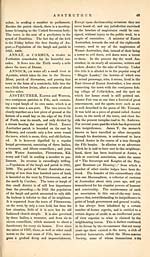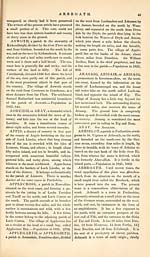Gazetteer of Scotland > Volume 1
(72) Page 44 - ANS
Download files
Complete book:
Individual page:
Thumbnail gallery: Grid view | List view

44
ANTONINUS' WALL.
printed, and attracted considerable attention,
The manse of Easter Anstrather is a some-
what remarkable building; it was built as a
gift to the parish, at the end of the sixteenth
century, by James Melville, who was then
minister of the parish, and an eminent figurant
in the turbulent councils of the Scottish
church, and nephew to the more celebrated
Andrew Melville.
ANTONINUS' WALL, the name given
to the wall erected by the Romans, to connect
a chain of forts betwixt the firths of Forth and
Clyde, and protect their conquests from the
incursions of the Caledonians and other savages
in the north. While Agricola was in Britain,
as governor under Domitian in the first cen-
tury, he constructed these forts or stations, and
the intermediate spaces were closed in, in the
year of our Lord 140, by Lollius Urbicus, the
lieutenant of Pius Antoninus, then emperor of
the Roman territories. Originally the wall
was composed of a turf or earthen rampart
erected on foundations of stone. In rearing
it the first thing done was to cut a ditch fifteen
feet wide at top, and sloping down at an angle
of 45 degrees. The earth cast out was placed
on the inner side, and assisted in raising the
height of the embankment or wall to about
twenty-four feet. In some exposed and other
places it was faced with stone, and along the
inner side for a length of forty miles, which
was its whole extent, there was constructed a
paved way of nearly six feet broad for the con-
venience of sentinels, and the march of the
legions hurrying hither and thither in cases of
emergency. Its extreme point in the east is
generally supposed to have been near Aber-
corn, on the south shore of the Firth of Forth,
and its western termination at Dunglass Castle,
or OH Kilpatrick, on the Clyde, both of these
strengths being of Roman architecture, and
built to defend the boundaries of the rampart.
The wall so formed and so curiously defended was
the northern boundary of that wonderful empire
which extended from thence southward to the
foot of Mount Atlas in Africa, a distance of
two thousand miles. Subsequent Roman
generals improved the wall of Antoninus, which
came to be called by the name of Graham's
dyke, a title it still possesses to the exclusion
of the other. How it should have acquired
such a designation has puzzled antiquaries,
some of whom, with more ingenuity than feasi-
bility, deduce it from the word grim, because it
was first repaired and strengthened by the empe-
ror Septimus Severus, that is Septimus the se-
vere or grim. The popular tradition of the wall
having received the name of Graham's dyke
from a Caledonian hero called Graham being
the first to break through it in the early part
of the fifth century, seems the more correct
mode of explanation. This explanation is
countenanced by a comparatively modern and
ungrammatical inscription discovered on a block
of black marble, which came to light in the
pulling down of the old church of Falkirk :
FVNERATV9
HIC. DEZN
ROB. GRAH-M,
ILLE. EVERSVS
VALL. SEVERVS
a. c. 415.
FERGVSIOVS II.
R. SCO.
Throughout the district of country through
which the wall of Antoninus stretches its
straight line, nearly heedless of impediments,
scarcely a vestige of it now remains, and its loca-
lity has only in many instances been establish-
ed by the discovery of its foundations and other
vestigia, in the progress of modern agricultural
improvement. Fragments of armour, coins,
arms, and weapons evidently of Roman origin
have been from time to time dug up. During
last century a still more significant trace of the
Roman power was exposed in the discovery of
a stone whereon was the following inscription :
"iMPERATORECiESARE TlTO AuLIO AnTONINO
AuGCSTO PlO PATRE PATRIAE COHORS FRI-,
MA TuNGRORUM FECIT MILLE PASSUUM." In
the reign of the Emperor Casar Titus Au-
lius Antoninus, the pious, and the father of
his country, the first cohort of the Tungri
made a thousand paces [of this rampart]. The
Tungri were one of those continental tribes
whom the Romans had conquered and pressed
into their service as auxiliaries. There were
three cohorts of them in Britain, according to
Tacitus, and it is understood that they were the
progenitors of the Ligeois of the present time.
In the course of cutting the Forth and Clyde
Canal, which follows a line parallel with,
and at no great distance from the wall, a
greater curiosity was discovered in the shape
of a Roman granary or cell, which, when open-
ed, contained about a hundred bolls of wheat.
The grain was of a blackish colour but not de-
ANTONINUS' WALL.
printed, and attracted considerable attention,
The manse of Easter Anstrather is a some-
what remarkable building; it was built as a
gift to the parish, at the end of the sixteenth
century, by James Melville, who was then
minister of the parish, and an eminent figurant
in the turbulent councils of the Scottish
church, and nephew to the more celebrated
Andrew Melville.
ANTONINUS' WALL, the name given
to the wall erected by the Romans, to connect
a chain of forts betwixt the firths of Forth and
Clyde, and protect their conquests from the
incursions of the Caledonians and other savages
in the north. While Agricola was in Britain,
as governor under Domitian in the first cen-
tury, he constructed these forts or stations, and
the intermediate spaces were closed in, in the
year of our Lord 140, by Lollius Urbicus, the
lieutenant of Pius Antoninus, then emperor of
the Roman territories. Originally the wall
was composed of a turf or earthen rampart
erected on foundations of stone. In rearing
it the first thing done was to cut a ditch fifteen
feet wide at top, and sloping down at an angle
of 45 degrees. The earth cast out was placed
on the inner side, and assisted in raising the
height of the embankment or wall to about
twenty-four feet. In some exposed and other
places it was faced with stone, and along the
inner side for a length of forty miles, which
was its whole extent, there was constructed a
paved way of nearly six feet broad for the con-
venience of sentinels, and the march of the
legions hurrying hither and thither in cases of
emergency. Its extreme point in the east is
generally supposed to have been near Aber-
corn, on the south shore of the Firth of Forth,
and its western termination at Dunglass Castle,
or OH Kilpatrick, on the Clyde, both of these
strengths being of Roman architecture, and
built to defend the boundaries of the rampart.
The wall so formed and so curiously defended was
the northern boundary of that wonderful empire
which extended from thence southward to the
foot of Mount Atlas in Africa, a distance of
two thousand miles. Subsequent Roman
generals improved the wall of Antoninus, which
came to be called by the name of Graham's
dyke, a title it still possesses to the exclusion
of the other. How it should have acquired
such a designation has puzzled antiquaries,
some of whom, with more ingenuity than feasi-
bility, deduce it from the word grim, because it
was first repaired and strengthened by the empe-
ror Septimus Severus, that is Septimus the se-
vere or grim. The popular tradition of the wall
having received the name of Graham's dyke
from a Caledonian hero called Graham being
the first to break through it in the early part
of the fifth century, seems the more correct
mode of explanation. This explanation is
countenanced by a comparatively modern and
ungrammatical inscription discovered on a block
of black marble, which came to light in the
pulling down of the old church of Falkirk :
FVNERATV9
HIC. DEZN
ROB. GRAH-M,
ILLE. EVERSVS
VALL. SEVERVS
a. c. 415.
FERGVSIOVS II.
R. SCO.
Throughout the district of country through
which the wall of Antoninus stretches its
straight line, nearly heedless of impediments,
scarcely a vestige of it now remains, and its loca-
lity has only in many instances been establish-
ed by the discovery of its foundations and other
vestigia, in the progress of modern agricultural
improvement. Fragments of armour, coins,
arms, and weapons evidently of Roman origin
have been from time to time dug up. During
last century a still more significant trace of the
Roman power was exposed in the discovery of
a stone whereon was the following inscription :
"iMPERATORECiESARE TlTO AuLIO AnTONINO
AuGCSTO PlO PATRE PATRIAE COHORS FRI-,
MA TuNGRORUM FECIT MILLE PASSUUM." In
the reign of the Emperor Casar Titus Au-
lius Antoninus, the pious, and the father of
his country, the first cohort of the Tungri
made a thousand paces [of this rampart]. The
Tungri were one of those continental tribes
whom the Romans had conquered and pressed
into their service as auxiliaries. There were
three cohorts of them in Britain, according to
Tacitus, and it is understood that they were the
progenitors of the Ligeois of the present time.
In the course of cutting the Forth and Clyde
Canal, which follows a line parallel with,
and at no great distance from the wall, a
greater curiosity was discovered in the shape
of a Roman granary or cell, which, when open-
ed, contained about a hundred bolls of wheat.
The grain was of a blackish colour but not de-
Set display mode to: Large image | Transcription
Images and transcriptions on this page, including medium image downloads, may be used under the Creative Commons Attribution 4.0 International Licence unless otherwise stated. ![]()
| Gazetteers of Scotland, 1803-1901 > Gazetteer of Scotland > Volume 1 > (72) Page 44 - ANS |
|---|
| Permanent URL | https://digital.nls.uk/97425226 |
|---|
| Description | Volume I: Abbey to Glenartney. |
|---|---|
| Attribution and copyright: |
|
| Description | By Robert Chambers and William Chambers. Glasgow: Blackie & Son, 1838. 2 volumes. |
|---|---|
| Shelfmark | NF.1461.g.7 |
| Additional NLS resources: | |

